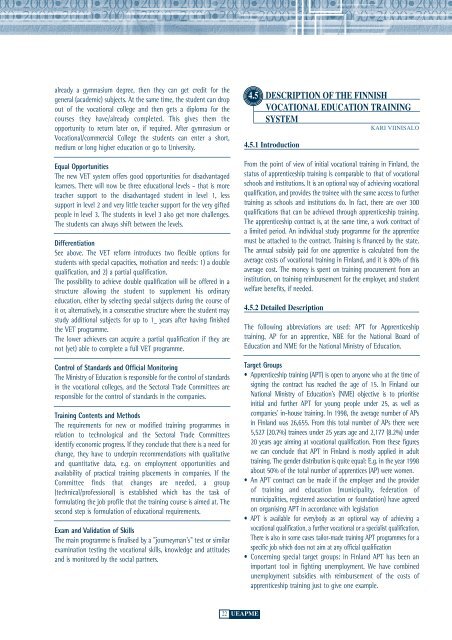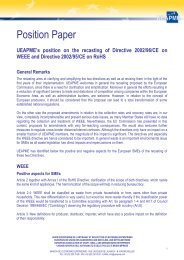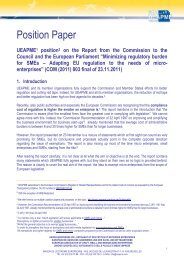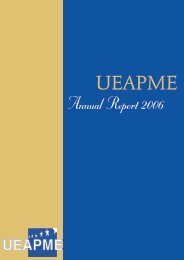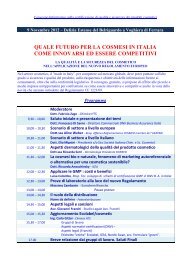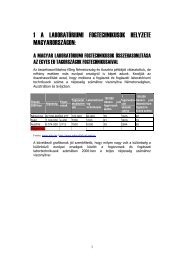Quality in Apprenticeship in the European Union - UEAPME
Quality in Apprenticeship in the European Union - UEAPME
Quality in Apprenticeship in the European Union - UEAPME
Create successful ePaper yourself
Turn your PDF publications into a flip-book with our unique Google optimized e-Paper software.
already a gymnasium degree, <strong>the</strong>n <strong>the</strong>y can get credit for <strong>the</strong><br />
general (academic) subjects. At <strong>the</strong> same time, <strong>the</strong> student can drop<br />
out of <strong>the</strong> vocational college and <strong>the</strong>n gets a diploma for <strong>the</strong><br />
courses <strong>the</strong>y have/already completed. This gives <strong>the</strong>m <strong>the</strong><br />
opportunity to return later on, if required. After gymnasium or<br />
Vocational/commercial College <strong>the</strong> students can enter a short,<br />
medium or long higher education or go to University.<br />
Equal Opportunities<br />
The new VET system offers good opportunities for disadvantaged<br />
learners. There will now be three educational levels – that is more<br />
teacher support to <strong>the</strong> disadvantaged student <strong>in</strong> level 1, less<br />
support <strong>in</strong> level 2 and very little teacher support for <strong>the</strong> very gifted<br />
people <strong>in</strong> level 3. The students <strong>in</strong> level 3 also get more challenges.<br />
The students can always shift between <strong>the</strong> levels.<br />
Differentiation<br />
See above. The VET reform <strong>in</strong>troduces two flexible options for<br />
students with special capacities, motivation and needs: 1) a double<br />
qualification, and 2) a partial qualification.<br />
The possibility to achieve double qualification will be offered <strong>in</strong> a<br />
structure allow<strong>in</strong>g <strong>the</strong> student to supplement his ord<strong>in</strong>ary<br />
education, ei<strong>the</strong>r by select<strong>in</strong>g special subjects dur<strong>in</strong>g <strong>the</strong> course of<br />
it or, alternatively, <strong>in</strong> a consecutive structure where <strong>the</strong> student may<br />
study additional subjects for up to 1_ years after hav<strong>in</strong>g f<strong>in</strong>ished<br />
<strong>the</strong> VET programme.<br />
The lower achievers can acquire a partial qualification if <strong>the</strong>y are<br />
not (yet) able to complete a full VET programme.<br />
Control of Standards and Official Monitor<strong>in</strong>g<br />
The M<strong>in</strong>istry of Education is responsible for <strong>the</strong> control of standards<br />
<strong>in</strong> <strong>the</strong> vocational colleges, and <strong>the</strong> Sectoral Trade Committees are<br />
responsible for <strong>the</strong> control of standards <strong>in</strong> <strong>the</strong> companies.<br />
Tra<strong>in</strong><strong>in</strong>g Contents and Methods<br />
The requirements for new or modified tra<strong>in</strong><strong>in</strong>g programmes <strong>in</strong><br />
relation to technological and <strong>the</strong> Sectoral Trade Committees<br />
identify economic progress. If <strong>the</strong>y conclude that <strong>the</strong>re is a need for<br />
change, <strong>the</strong>y have to underp<strong>in</strong> recommendations with qualitative<br />
and quantitative data, e.g. on employment opportunities and<br />
availability of practical tra<strong>in</strong><strong>in</strong>g placements <strong>in</strong> companies. If <strong>the</strong><br />
Committee f<strong>in</strong>ds that changes are needed, a group<br />
(technical/professional) is established which has <strong>the</strong> task of<br />
formulat<strong>in</strong>g <strong>the</strong> job profile that <strong>the</strong> tra<strong>in</strong><strong>in</strong>g course is aimed at. The<br />
second step is formulation of educational requirements.<br />
Exam and Validation of Skills<br />
The ma<strong>in</strong> programme is f<strong>in</strong>alised by a "journeyman’s" test or similar<br />
exam<strong>in</strong>ation test<strong>in</strong>g <strong>the</strong> vocational skills, knowledge and attitudes<br />
and is monitored by <strong>the</strong> social partners.<br />
4.5 DESCRIPTION OF THE FINNISH<br />
VOCATIONAL EDUCATION TRAINING<br />
SYSTEM<br />
KARI VIINISALO<br />
4.5.1 Introduction<br />
From <strong>the</strong> po<strong>in</strong>t of view of <strong>in</strong>itial vocational tra<strong>in</strong><strong>in</strong>g <strong>in</strong> F<strong>in</strong>land, <strong>the</strong><br />
status of apprenticeship tra<strong>in</strong><strong>in</strong>g is comparable to that of vocational<br />
schools and <strong>in</strong>stitutions. It is an optional way of achiev<strong>in</strong>g vocational<br />
qualification, and provides <strong>the</strong> tra<strong>in</strong>ee with <strong>the</strong> same access to fur<strong>the</strong>r<br />
tra<strong>in</strong><strong>in</strong>g as schools and <strong>in</strong>stitutions do. In fact, <strong>the</strong>re are over 300<br />
qualifications that can be achieved through apprenticeship tra<strong>in</strong><strong>in</strong>g.<br />
The apprenticeship contract is, at <strong>the</strong> same time, a work contract of<br />
a limited period. An <strong>in</strong>dividual study programme for <strong>the</strong> apprentice<br />
must be attached to <strong>the</strong> contract. Tra<strong>in</strong><strong>in</strong>g is f<strong>in</strong>anced by <strong>the</strong> state.<br />
The annual subsidy paid for one apprentice is calculated from <strong>the</strong><br />
average costs of vocational tra<strong>in</strong><strong>in</strong>g <strong>in</strong> F<strong>in</strong>land, and it is 80% of this<br />
average cost. The money is spent on tra<strong>in</strong><strong>in</strong>g procurement from an<br />
<strong>in</strong>stitution, on tra<strong>in</strong><strong>in</strong>g reimbursement for <strong>the</strong> employer, and student<br />
welfare benefits, if needed.<br />
4.5.2 Detailed Description<br />
The follow<strong>in</strong>g abbreviations are used: APT for <strong>Apprenticeship</strong><br />
tra<strong>in</strong><strong>in</strong>g, AP for an apprentice, NBE for <strong>the</strong> National Board of<br />
Education and NME for <strong>the</strong> National M<strong>in</strong>istry of Education.<br />
Target Groups<br />
• <strong>Apprenticeship</strong> tra<strong>in</strong><strong>in</strong>g (APT) is open to anyone who at <strong>the</strong> time of<br />
sign<strong>in</strong>g <strong>the</strong> contract has reached <strong>the</strong> age of 15. In F<strong>in</strong>land our<br />
National M<strong>in</strong>istry of Education’s (NME) objective is to prioritise<br />
<strong>in</strong>itial and fur<strong>the</strong>r APT for young people under 25, as well as<br />
companies’ <strong>in</strong>-house tra<strong>in</strong><strong>in</strong>g. In 1998, <strong>the</strong> average number of APs<br />
<strong>in</strong> F<strong>in</strong>land was 26,655. From this total number of APs <strong>the</strong>re were<br />
5,527 (20.7%) tra<strong>in</strong>ees under 25 years age and 2,177 (8.2%) under<br />
20 years age aim<strong>in</strong>g at vocational qualification. From <strong>the</strong>se figures<br />
we can conclude that APT <strong>in</strong> F<strong>in</strong>land is mostly applied <strong>in</strong> adult<br />
tra<strong>in</strong><strong>in</strong>g. The gender distribution is quite equal: E.g. <strong>in</strong> <strong>the</strong> year 1998<br />
about 50% of <strong>the</strong> total number of apprentices (AP) were women.<br />
• An APT contract can be made if <strong>the</strong> employer and <strong>the</strong> provider<br />
of tra<strong>in</strong><strong>in</strong>g and education (municipality, federation of<br />
municipalities, registered association or foundation) have agreed<br />
on organis<strong>in</strong>g APT <strong>in</strong> accordance with legislation<br />
• APT is available for everybody as an optional way of achiev<strong>in</strong>g a<br />
vocational qualification, a fur<strong>the</strong>r vocational or a specialist qualification.<br />
There is also <strong>in</strong> some cases tailor-made tra<strong>in</strong><strong>in</strong>g APT programmes for a<br />
specific job which does not aim at any official qualification<br />
• Concern<strong>in</strong>g special target groups: <strong>in</strong> F<strong>in</strong>land APT has been an<br />
important tool <strong>in</strong> fight<strong>in</strong>g unemployment. We have comb<strong>in</strong>ed<br />
unemployment subsidies with reimbursement of <strong>the</strong> costs of<br />
apprenticeship tra<strong>in</strong><strong>in</strong>g just to give one example.<br />
22 <strong>UEAPME</strong>


